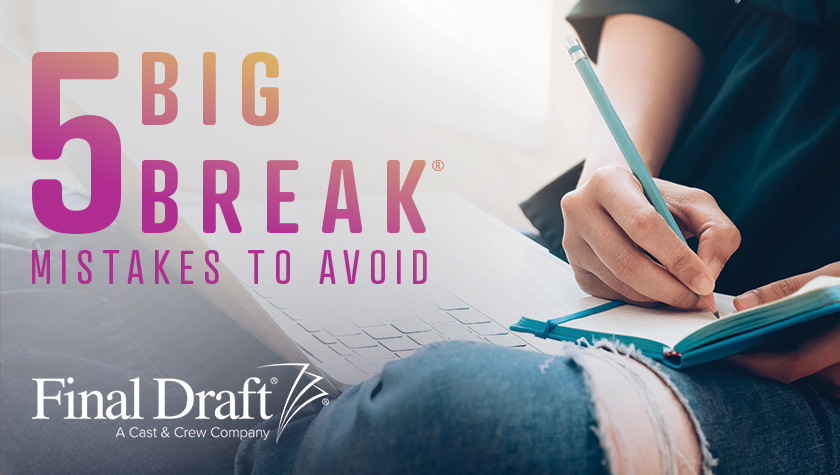The craft of economic writing (AKA killing your darlings)
June 6, 2022
Less is…
See what your clever brain did there? Go ahead and overwrite. Get it all out... No holds barred. Seize the day. Wring out that brain sponge all over the keyboard.
Then…
Slice your darlings and favorite descriptors out of the script with a katana blade.
Unless the color and brand of the protagonist’s backpack are important to the story, they need to go. Unless you are directing this movie, you may not dictate exactly how many breaths your character takes and which cheek the silvery tear of longing will run down (and even then, please don’t. Leave some stuff up to the actors and cinematographer).
How many rooms are in that mansion? What is the exact chemical composition of that exoskeleton? What year did Grandpa move to Cincinnati?
Unless which side of the face that tear runs down signifies that we’re now in a mirror universe, or something is going to happen in every single room of that mansion and we’re counting down to the last scene in the last room, or we’ve established that only a specific supervillain's power can penetrate that particular exoskeleton, I don’t give a FCUK. The reader’s brain will fill in the details of what the “grand manse” or the “Zoxoid Cyberskin” looks like just as easily as flipping fcuk to fkuc.
Script Readers (or story analysts) have absolutely no time for your nonsense. They are trying desperately to get through a stack of scripts, and they want very much to give your script the attention it deserves. Every word in print matters. If you get hung up on the pink flowers of the floral pattern of the pale yellow wallpaper, so will the reader. If there’s no payoff as to why we looked so hard at that damn wallpaper for an entire paragraph, the reader feels cheated. BORED. And boring is definitely the last thing anyone wants their script to be.
I’m far from against lavish settings or slow burns. But if you ever look at any script from Downton Abbey or Game of Thrones you will find that the action paragraphs are still only 2-3 sentences max. If there is a pheasant recipe that lends depth to the scene, it will be drunkenly slurred by Tyrone in a line of dialogue or two where he’s actually revealing through his tone how much he misses his slain wife.
Every action-line paragraph, especially scene descriptions, should be 1-3 sentences. In fact, it's an industry standard. It’s not even a matter of catering to the overtaxed schedules and attention spans of readers. It’s a mark of professionalism and artistry. If you can manage to take what was a 6-sentence paragraph of complex scenic action and boil it down to 3 sentences of economical poetry, you are setting people’s brains on fire. Scripts are like a magic trick or a literary Tardis in that sense: an infinitely huge world crammed into a tight 30 or 60 or 100 (or so) pages.
It may be that all of the Action in those long paragraphs is absolutely necessary to the plot. In that case, it’s a simple formatting issue.
Chop up those paragraphs. Chop 'em up fine.
Oftentimes, a single sentence works as a paragraph.
White space is crucial not only to allow a reader’s eye to rest and take in information, but it creates a natural shot list. Each line of white space is a transition.
Most screenwriters know by now that WE SEE:, C.U. on:, etc. are cheats that take the reader out of the action and remind us that the story we’re reading is meant to be watched on a screen instead of allowing the reader to imagine the images in the writer’s head as their own.
However, I sympathize that it can be difficult to find creative ways of describing camera directions if they’re necessary to the writer’s vision. I have a lot of suggestions for how to write camera directions without writing camera directions, but for now, staying on topic:
White space creates time.
Distance.
The words pause for a moment, take time to breathe. Tension builds.
Then:
Back to the frenetic action! The characters move and speak once again. Swords unsheath. The car crashes through the wall. Rook takes Bishop. The crowd roars.
Similarly, commitment to economy and breathing room must be applied to dialogue. While throwing in a few likes and ums often make dialogue seem more natural, there’s a reason why that was a punchline on an episode of HBO’s Barry. Keep it all killer, no filler. That goes for every like, um, y’know, gosh, and fukc.
Especially f*cks -- they are jarring, attention-getting, annoying or sexy, but mostly annoying if used too often. Same for other swears. Yeah, Trainspotting,” Scorsese, “that’s how people talk in that neighborhood.” I know. I swear so much in life that if I wrote the way I talked there’d be nothing but expletives laced together by a connective tissue of conjunctions. We don’t have to be prudes, but it doesn’t hurt to take another look at your vast, apocalyptic wasteland of f-bombs and decide which ones are killer vs. filler.
Not as offensive, but watch out for just, really, and other adverbs too.
I like monologues... I do. A good one can make your script into something for the ages that will be quoted by teenagers and performed in auditions for generations to come.
Grab your katana and slash. Burn.
Again, I believe in overwriting and getting it all down, but then, once you got it all out of your system, take some time with that 2-page screed your character just effluviated. What are they trying to say? Which parts of that speech truly matter? It will come down to about 30% or even 25% of those gorgeous words you wrote. Subtract all but those.
Is there still a giant block of dialogue sitting there making the reader's eyes water? What is your character doing while they talk? Who else is in the room with that character and what’s their reaction (embarrassedly shuffling their feet, rolling their eyes, gasping with exhilaration) to what the speaker is speechifying about?
What else is going on in the room, outside the window, down the street, 10 years ago, in a parallel universe, while that character is saying what must be said in this particular story? Break that monologue up with action lines that tell us. Remember that film and television are visual mediums.
In short (too late!), do less. You and your readers will get more.
Written by: Chris Pittas




